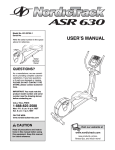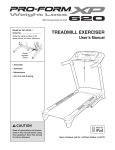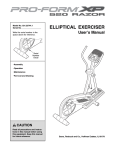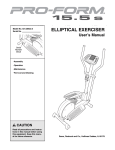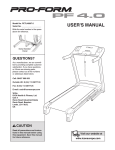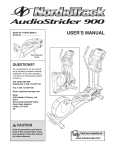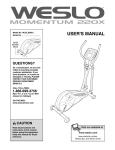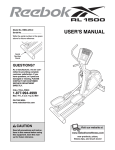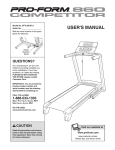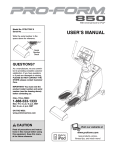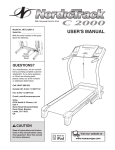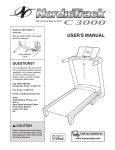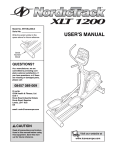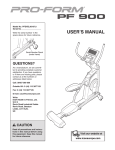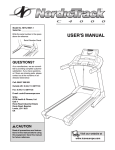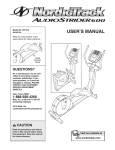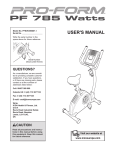Download USER`S MANUAL - Icon Heath & Fitness
Transcript
Model No. NTEVEL96207.0 Serial No. Write the serial number in the space above for reference Serial Number Decal QUESTIONS? As a manufacturer, we are committed to providing complete customer satisfaction. If you have questions, or if there are missing parts, please contact us: Call: 08457 089 009 Outside UK: 0 (44) 113 3877133 Fax: 0 (44) 113 3877125 E-mail: [email protected] Write: ICON Health & Fitness, Ltd. Unit 4 Revie Road Industrial Estate Revie Road, Beeston Leeds, LS11 8JG, UK CAUTION Read all precautions and instructions in this manual before using this equipment. Keep this manual for future reference. USER’S MANUAL TABLE OF CONTENTS WARNING DECAL PLACEMENT . . . . . . . . . . . . . . . . . . . . . . . . . . . . . . . . . . . . . . . . . . . . . . . . . . . . . . . . . . . . . .2 IMPORTANT PRECAUTIONS . . . . . . . . . . . . . . . . . . . . . . . . . . . . . . . . . . . . . . . . . . . . . . . . . . . . . . . . . . . . . . . .3 BEFORE YOU BEGIN . . . . . . . . . . . . . . . . . . . . . . . . . . . . . . . . . . . . . . . . . . . . . . . . . . . . . . . . . . . . . . . . . . . . . .4 ASSEMBLY . . . . . . . . . . . . . . . . . . . . . . . . . . . . . . . . . . . . . . . . . . . . . . . . . . . . . . . . . . . . . . . . . . . . . . . . . . . . . . .5 HOW TO USE THE ELLIPTICAL EXERCISER . . . . . . . . . . . . . . . . . . . . . . . . . . . . . . . . . . . . . . . . . . . . . . . . . .12 HOW TO USE THE CHEST PULSE SENSOR . . . . . . . . . . . . . . . . . . . . . . . . . . . . . . . . . . . . . . . . . . . . . . . . . .14 MAINTENANCE AND TROUBLESHOOTING . . . . . . . . . . . . . . . . . . . . . . . . . . . . . . . . . . . . . . . . . . . . . . . . . . .21 EXERCISE GUIDELINES . . . . . . . . . . . . . . . . . . . . . . . . . . . . . . . . . . . . . . . . . . . . . . . . . . . . . . . . . . . . . . . . . . .22 PART LIST . . . . . . . . . . . . . . . . . . . . . . . . . . . . . . . . . . . . . . . . . . . . . . . . . . . . . . . . . . . . . . . . . . . . . . . . . . . . . .24 EXPLODED DRAWING . . . . . . . . . . . . . . . . . . . . . . . . . . . . . . . . . . . . . . . . . . . . . . . . . . . . . . . . . . . . . . . . . . . .26 ORDERING REPLACEMENT PARTS . . . . . . . . . . . . . . . . . . . . . . . . . . . . . . . . . . . . . . . . . . . . . . . . . .Back Cover WARNING DECAL PLACEMENT 258868 258869 The warning decal shown here has been applied in the location shown. If the decal is missing or illegible, call the telephone number on the front cover of this manual and request a free replacement decal. Apply the decal in the location shown. Note: The decal may not be shown at actual size. 258870 258865 NordicTrack is a registered trademark of ICON IP, Inc. 2 25 IMPORTANT PRECAUTIONS WARNING: To reduce the risk of serious injury, read all important precautions and instructions in this manual and all warnings on your elliptical exerciser before using your elliptical exerciser. ICON assumes no responsibility for personal injury or property damage sustained by or through the use of this product. 1. Before beginning any exercise program, consult your physician. This is especially important for persons over the age of 35 or persons with pre-existing health problems. 8. Wear appropriate exercise clothes when exercising; do not wear loose clothes that could become caught on your elliptical exerciser. Always wear athletic shoes for foot protection. 2. It is the responsibility of the owner to ensure that all users of the elliptical exerciser are adequately informed of all precautions. 9. Hold the handgrip pulse sensor or the upper body arms when mounting, dismounting, or using your elliptical exerciser. 3. Your elliptical exerciser is intended for home use only. Do not use your elliptical exerciser in a commercial, rental, or institutional setting. 10. Keep your back straight while using your elliptical exerciser; do not arch your back. 11. The pulse sensor is not a medical device. Various factors, including the user’s movement, may affect the accuracy of heart rate readings. The pulse sensor is intended only as an exercise aid in determining heart rate trends in general. 4. Keep your elliptical exerciser indoors, away from moisture and dust. Place your elliptical exerciser on a level surface, with a mat beneath it to protect the floor or carpet. Make sure that there is enough clearance around your elliptical exerciser to mount, dismount, and use it. 12. When you stop exercising, allow the pedals to slowly come to a stop. 5. Inspect and properly tighten all parts regularly. Replace any worn parts immediately. 13. If you feel pain or dizziness while exercising, stop immediately and cool down. 6. Keep children under age 12 and pets away from your elliptical exerciser at all times. 14. Use your elliptical exerciser only as described in this manual. 7. Your elliptical exerciser should not be used by persons weighing more than 275 lbs. (124 kg). 3 BEFORE YOU BEGIN Thank you for purchasing the revolutionary NordicTrack® CX 650 elliptical exerciser. The CX 650 elliptical exerciser provides a wide array of features designed to make your workouts at home more effective and enjoyable—and when you’re not exercising, the unique elliptical exerciser can be folded out of the way. tions after reading this manual, please see the front cover of this manual. To help us assist you, note the product model number and serial number before contacting us. The model number and the location of the serial number decal are shown on the front cover of this manual. Before reading further, please familiarize yourself with the parts that are labeled in the drawing below. For your benefit, read this manual carefully before you use the elliptical exerciser. If you have ques- Fan Upper Body Arm Console Pulse Sensor Water Bottle Holder* Wheel Pedal Pedal Disc Latch Button Handle *No water bottle is included 4 ASSEMBLY Assembly requires two persons. Place all parts of the elliptical exerciser in a cleared area and remove the packing materials. Do not dispose of the packing materials until assembly is completed. Assembly requires the included tools and your own Phillips screwdriver wrench , and rubber mallet . , adjustable As you assemble the elliptical exerciser, use the drawings below to identify small parts. The number in parentheses below each drawing is the key number of the part, from the PART LIST near the end of the manual. The number following the parentheses is the quantity needed for assembly. Note: Some small parts may have been preassembled. If a part is not in the hardware kit, check to see if it has been preassembled. Wave Washer (80)–2 Large Wave Washer (89)–4 M8 Split Washer (97)–16 M10 Split Washer (99)–2 M8 x 19mm Button Screw (85)–6 M8 Washer (95)–4 M8 x 23mm x 1mm Washer (31)–4 M10 Nylon Locknut (82)–2 M8 x 23mm Shoulder Screw (86)–4 M4 x 16mm Round Head Screw (78)–25 M8 x 23mm x 2mm Washer (96)–8 M8 x 14mm Button Screw (84)–6 M10 x 78mm Carriage Bolt (92)–2 M8 x 45mm Button Screw (90)–6 M10 x 80mm Button Screw (93)–2 5 1. 1 To make assembly easier, read the information on page 5 before you begin assembling the elliptical exerciser. 92 See HOW TO FOLD AND UNFOLD THE ELLIPTICAL EXERCISER on page 12 and unfold the elliptical exerciser. While another person lifts the front of the Frame (1), attach the Front Stabilizer (4) to the Frame with two M10 x 78mm Carriage Bolts (92) and two M10 Nylon Locknuts (82). 4 2. Attach the Left and Right Frame Covers (36, 37) around the Frame (1) with four M4 x 16mm Round Head Screws (78). 1 2 82 82 37 78 1 78 3. With the help of another person, carefully tip the elliptical exerciser onto its side. Tighten a Leveling Foot (40) into the Frame (1). Then, return the elliptical exerciser to the upright position. 36 3 1 Orient the Rear Stabilizer (3) as shown. While another person lifts the Folding Frame (2), attach the Rear Stabilizer to the Folding Frame with two M10 x 80mm Button Screws (93) and two M10 Split Washers (99). 2 40 99 3 6 99 93 4. While another person holds the Upright (10) near the Frame (1), connect the Upper Wire Harness (65) to the Lower Wire Harness (64). 4 Avoid pinching the Wire Harnesses (64, 65) during this step Then, insert the Upright (10) into the Frame (1). Attach the Upright with four M8 x 19mm Button Screws (85) and four M8 Split Washers (97). Do not tighten the Button Screws yet. Avoid pinching the Wire Harnesses (64, 65) during this step. 10 65 97 85 5. Orient the Left and Right Upright Covers (19, 20) as shown. Then, attach the Upright Covers around the Upright (10) with five M4 x 16mm Round Head Screws (78). 97 64 85 97 1 97 5 78 78 78 7 19 10 20 6. Apply a generous amount of the included grease to the Upper Body Axle (71). Insert the Upper Body Axle into the Upright (10). Be careful not to damage the Upper Wire Harness (65). 6 65 Apply a small amount of grease to a Wave Washer (80). Slide the Wave Washer onto the left end of the Upper Body Axle (71). 71 10 Grease Identify the Left Upper Body Leg (24), which is marked with an “L” sticker, and orient it as shown. Slide the Left Upper Body Leg onto the left side of the Upper Body Axle (71). 85 Attach the Left Upper Body Leg (24) to the Upper Body Axle (71) with an M8 x 19mm Button Screw (85) and an M8 x 23mm x 2mm Washer (96). 96 Grease 80 96 85 72 80 24 Repeat this step for the Right Upper Body Leg (72). 7. Attach the Left Upper Body Arm (22) to the Left Upper Body Leg (24) with three M8 x 14mm Button Screws (84) and three M8 Split Washers (97). 7 23 Attach the Right Upper Body Arm (23) in the same way. 22 84 97 97 24 8 8. Hold the Left Rear Upper Body Cover (26) and the Left Front Upper Body Cover (27) around the Left Upper Body Leg (24). Attach the Upper Body Covers with five M4 x 16mm Round Head Screws (78). 8 Attach the Right Rear Upper Body Cover (28) and the Right Front Upper Body Cover (29) in the same way. 78 29 78 28 27 26 24 9. The Console (11) can be operated with four 1.5V “D” batteries; alkaline batteries are recommended. IMPORTANT: If the elliptical exerciser has been exposed to cold temperatures, allow it to warm to room temperature before inserting batteries into the Console. If you do not do this, the console displays or other electronic components may become damaged. Remove the battery cover and insert four batteries into the Console. Make sure that the batteries are oriented as shown at the right. Then, reattach the battery cover. 78 9 11 The Console (11) can also be operated with a regulated 6-volt DC 2-amp power supply (not included). To purchase a power supply, call the telephone number on the front cover of this manual. To avoid damaging the console, use only a manufacturer-supplied power supply. Plug one end of the power supply into the jack on the elliptical exerciser; plug the other end into an outlet installed in accordance with all local codes and ordinances. Batteries 9 Battery Cover 10. While another person holds the Console (11) near the Upright (10), connect the console wire harness to the Upper Wire Harness (65). 10 Console Wire Harness Attach the Console (11) to the Upright (10) with four M4 x 16mm Round Head Screws (78). Avoid pinching the wire harnesses during this step. 11 10 65 78 11. Orient a Link Arm (30) as shown. Attach the Left Pedal (34) to the Link Arm with three M8 x 45mm Button Screws (90), three M8 Split Washers (97), and three M8 x 23mm x 2mm Washers (96). Avoid pinching the wire harnesses during this step 11 34 78 Attach a Pedal Arm Cover (39) to the Link Arm (30) with an M4 x 16mm Round Head Screw (78). 96 97 Repeat this step for the Right Pedal (not shown) and the other Link Arm (not shown). 90 10 96 97 39 30 12. Apply a generous amount of grease to the axle on the Left Upper Body Leg (24) and to the axle on the left Crank Arm (55). Then, apply grease to two Large Wave Washers (89). 12 24 32 Grease Slide an Upper Body Leg Spacer (9) and a Large Wave Washer (89) onto the Left Upper Body Leg (24). Make sure that the flat side of the Upper Body Leg Spacer is facing outward. Then, slide the other Large Wave Washer onto the left Crank Arm (55). 66 31 86 95 Slide the left Pedal Arm (32) onto the Left Upper Body Leg (24) while sliding the left Link Arm (30) onto the axle on the left Crank Arm (55). 9 89 32 30 Attach the Pedal Arm (32) to the Left Upper Body Leg (24) with an M8 x 23mm Shoulder Screw (86), an M8 Washer (95), an Axle Cover (66), and an M8 x 23mm x 1mm Washer (31). Then, attach the Link Arm (30) to the Crank Arm (55) with an M8 x 23mm Shoulder Screw (86), an M8 Washer (95), a Large Axle Cover (52), and an M8 x 23mm x 1mm Washer (31). 30 Repeat this step for the right Pedal Arm (32) and the right Link Arm (30). 95 See step 4. Tighten the M8 x 19mm Button Screws (85). 86 31 52 89 55 Grease 13. Make sure that all parts of the elliptical exerciser are properly tightened. Note: Some hardware may be left over after assembly is completed. To protect the floor or carpet from damage, place a mat under the elliptical exerciser. 11 HOW TO USE THE ELLIPTICAL EXERCISER HOW TO FOLD AND UNFOLD THE ELLIPTICAL EXERCISER HOW TO MOVE THE ELLIPTICAL EXERCISER To move the elliptical exerciser, first fold it as described at the left. Next, stand in front of the elliptical exerciser and place one foot against the center of the front stabilizer. Pull the transport handle backward until the elliptical exerciser will roll on the front wheels. Carefully move the elliptical exerciser to the desired position, and then lower it. When the elliptical exerciser is not in use, the frame can be folded out of the way. To fold the elliptical exerciser, lift the handle on the rear of the elliptical exerciser until the elliptical exerciser locks into the vertical position. Transport Handle Handle To unfold the elliptical exerciser, first hold the handle, press the latch button, and then lower the frame to the floor. Place your foot here Handle HOW TO LEVEL THE ELLIPTICAL EXERCISER Latch Button If the elliptical exerciser rocks slightly on your floor during use, turn one or both of the leveling feet beneath the base until the rocking motion is eliminated. If the elliptical exerciser flexes during use, turn the leveling foot beneath the center of the frame. 12 HOW TO EXERCISE ON THE ELLIPTICAL EXERCISER To mount the elliptical exerciser, hold the upper body arms and step onto the pedal that is in the lowest position. Next, step onto the other pedal. Push the pedals until they begin to move with a continuous motion. Upper Body Arms Note: The crank arms can turn in either direction. It is recommended that you turn the crank arms in the direction shown by the arrow at the right; however, for variety you can turn the crank arms in the opposite direction. Pedals To dismount the elliptical exerciser, wait until the pedals come to a complete stop. Note: The elliptical exerciser does not have a free wheel; the pedals will continue to move until the flywheel stops. When the pedals are stationary, step off the higher pedal first. Then, step off the lower pedal. Crank Arm 13 HOW TO USE THE CHEST PULSE SENSOR HOW TO PUT ON THE CHEST PULSE SENSOR • Store the chest pulse sensor in a warm, dry place. Do not store the chest pulse sensor in a plastic bag or other container that may trap moisture. The chest pulse sensor consists of two components: the chest strap and the sensor unit (see the drawing below). Insert the tab on one end of the chest strap into one end of the sensor unit, as shown in the inset drawing. Press the end of the sensor unit under the buckle on the chest strap. The tab should be flush with the front of the sensor unit. • Do not expose the chest pulse sensor to direct sunlight for extended periods of time; do not expose it to temperatures above 122° F (50° C) or below 14° F (-10° C). • Do not excessively bend or stretch the sensor unit when using or storing the chest pulse sensor. • Clean the sensor unit using a damp cloth—never use alcohol, abrasives, or chemicals. The chest strap may be hand washed and air dried. Chest Strap Tab Sensor Unit Sensor Unit CHEST PULSE SENSOR TROUBLESHOOTING The instructions below explain how the chest pulse sensor is used with the console. If the chest pulse sensor does not function properly, try the steps below. Buckle Next, wrap the chest pulse senLogo sor around your chest and attach the other end of the chest strap to the sensor unit. Adjust the length of the chest strap, if necessary. The chest pulse sensor should be under your clothes, tight against your skin, and as high under the pectoral muscles or breasts as is comfortable. Make sure that the logo on the sensor unit is facing forward and is right-side-up. • Make sure that you are wearing the chest pulse sensor as described at the left. Note: If the chest pulse sensor does not function when positioned as described, move it slightly lower or higher. • Use saline solution such as saliva or contact lens solution to wet the two electrode areas on the sensor unit. If heart rate readings do not appear until you begin perspiring, re-wet the electrode areas. • Make sure to position yourself near the console. For the console to display heart rate readings, the user must be within arm’s length of the console. • The chest pulse sensor is designed to work with people who have normal heart rhythms. Heart rate reading problems may be caused by medical conditions such as premature ventricular contractions (pvcs), tachycardia bursts, and arrhythmia. Pull the sensor unit away from your body a few inches and locate the two electrode areas on the inner side (the electrode areas are covered by shallow ridges). Using saline solution such as saliva or contact lens solution, wet both electrode areas. Return the sensor unit to a position against your chest. • The operation of the chest pulse sensor can be affected by magnetic interference caused by high power lines or other sources. If it is suspected that this is a problem, try relocating the exercise cycle. CHEST PULSE SENSOR CARE • Thoroughly dry the chest pulse sensor after each use. The chest pulse sensor is activated when the electrode areas are wetted and the heart rate monitor is put on; the chest pulse sensor shuts off when it is removed and the electrode areas are dried. If the chest pulse sensor is not dried after each use, it may remain activated longer than necessary, draining the battery prematurely. 14 CONSOLE DIAGRAM FEATURES OF THE CONSOLE The console also features the new iFIT Interactive Workout System. The iFIT Interactive Workout System is compatible with iFIT cards containing workout programs designed to help you achieve specific fitness goals. For example, lose unwanted pounds with the 8week Weight Loss program. iFIT programs control the resistance of the pedals while the voice of a personal trainer coaches you and motivates you through your workouts. One demo iFIT Card is included. Additional iFIT cards are available separately. To purchase iFIT Cards, go to www.iFIT.com or call the telephone number on the front cover of this manual. iFIT cards are also available at select stores. The advanced console offers an array of features designed to make your workouts more effective and enjoyable. When you select the manual mode of the console, you can change the resistance of the pedals with the touch of a button. As you exercise, the console will provide continuous exercise feedback. You can even measure your heart rate using the handgrip pulse sensor or the included chest pulse sensor. The console also offers four preset programs. Each program automatically changes the resistance of the pedals and prompts you to increase or decrease your pedaling speed as it guides you through an effective Locust You can even connect your MP3 player or CD player ELNE96207 workout. to the console’s sound system and listen to your ELSN59507 favorite music or audio books while you exercise. In addition, the console features two heart rate pro- NTEVEL96207.0 To use the manual mode of the console, follow the grams that change the resistance of the pedals to 23765.1 NTEL00507.0 steps beginning on page 16. To use a preset keep your heart rate near target heart rate settings program, see page 18. To use a heart rate program, while you exercise. see page 19. To use an iFIT program, see page 20. To use the stereo sound system, see page 20. 15 HOW TO USE THE MANUAL MODE 4. Follow your progress with the displays. Note: If there is a sheet of clear plastic on the face of the console, remove the plastic. The upper right section of the display can show the elapsed time, the distance (total revolutions) you have pedaled, the approximate number of calories you have burned, and the approximate number of grams of carbs you have burned. The display will change modes every few seconds. 1. Press any button on the console or begin pedaling to turn on the console. When you turn on the console, the display and the program target pacer will light. A tone will then sound and the console will be ready for use. 2. Select the manual mode. The lower right section of the display can show your pedaling pace (in revolutions per minute) and the resistance level of the pedals. The display will change modes every few seconds. The display will also show your heart rate when you use the handgrip pulse sensor or the included chest pulse sensor (see step 5 on page 17). When you turn on the console, the manual mode will be selected. If you have selected a program, reselect the manual mode by pressing any of the Programs buttons repeatedly until a track appears in the left side of the display. The left section of the display will show a track representing 640 revolutions. As you exercise, indicators will appear in succession around the track until the entire track appears. The track will then disappear and the indicators will again begin to appear in succession. 3. Begin pedaling and change the resistance of the pedals as desired. As you pedal, change the resistance of the pedals by pressing the OneTouch Resistance buttons. There are ten resistance levels. Note: After you press the buttons, it will take a moment for the pedals to reach the selected resistance level. To change the display mode, press the Display button repeatedly until the desired exercise information appears in the upper or lower right display. After several seconds, the display will change modes automatically as before. To view the total distance pedaled since the elliptical exerciser was purchased, press the Odometer button. The information will appear in the display for a few seconds. To view the trip distance, press the Odometer button a second time. To reset the trip distance, hold down the Odometer button for a few seconds. Note: The number on the right side of the display multiplied by the number on the left side equals the total distance or the trip distance. 16 6. Turn on the fan if desired. 5. Measure your heart rate if desired. To use the included chest pulse sensor, see page 14. To use the handgrip pulse sensor, follow the instructions below. Note: If you wear the chest pulse sensor and hold the handgrip pulse sensor at the same time, the console will not display your heart rate accurately. To turn on the fan at high speed, press the Fan button. To turn on the fan at low speed, press the Fan button a second time. To select the auto mode, press the Fan button a third time; while the auto mode is selected, the speed of the fan will automatically increase or decrease as you increase or decrease your pedaling speed. If there are sheets of clear Contacts plastic on the metal contacts on the handgrip pulse sensor, remove the plastic. In addition, make sure that your hands are clean. To measure your heart rate, hold the handgrip pulse sensor with your palms resting against the metal contacts. Avoid moving your hands or gripping the contacts tightly. Pivot the thumb tab on the right side of the fan to adjust the fan angle. Thumb Tab To turn off the fan, press the Fan button again. Note: If the pedals do not move for about thirty seconds, the fan will automatically turn off to conserve the batteries. 7. When you are finished exercising, the console will turn off automatically. When your pulse is detected, a heart-shaped symbol will flash in the display each time your heart beats and then your heart rate will be shown. For the most accurate heart rate reading, hold the contacts for at least 15 seconds. If the pedals do not move for several seconds, a series of tones will sound and the console will pause. If the pedals do not move for about five minutes, the console will turn off and the displays will be reset. If your heart rate is not shown, make sure that your hands are positioned as described. Be careful not to move your hands excessively or to squeeze the metal contacts tightly. For optimal performance, clean the metal contacts using a soft cloth; never use alcohol, abrasives, or chemicals to clean the contacts. 17 HOW TO USE A PRESET PROGRAM During the program, the program target pacer will prompt you to keep your pedaling pace near the target pace setting for the current segment. When a left indicator lights, increase your pace; when a right indicator lights, decrease your pace. When the center indicator lights, maintain your current pace. IMPORTANT: The program target pacer is intended only to provide a goal. Make sure to pedal at a pace that is comfortable for you. 1. Press any button on the console or begin pedaling to turn on the console. See step 1 on page 16. 2. Select a preset program. To select one of the four preset programs, press the Weight Loss, the Aerobic 1, the Aerobic 2, or the Performance button on the left side of the console. When you select a preset program, the name of the program and the maximum resistance level will appear in the display for a few seconds. A profile of the resistance levels of the program will also scroll across the left side of the display. If the resistance level for the current segment is too high or too low, you can manually override the resistance level by pressing the OneTouch Resistance buttons. However, when the current segment ends, the resistance of the pedals will automatically adjust to the resistance level for the next segment. If you stop pedaling for several seconds, a series of tones will sound and the program will pause. To restart the program, simply resume pedaling. The program will continue until the last segment of the profile ends. 3. Begin pedaling to start the program. 4. Follow your progress with the displays. Each program is divided into 30 one-minute segments. One resistance level and one target pace setting is programmed for each segment. Note: The same resistance level and/or target pace setting may be programmed for consecutive segments. See step 4 on page 16. 5. Measure your heart rate if desired. See step 5 on page 17. 6. Turn on the fan if desired. During the program, the program profile will show your progress (see the drawing above). The flashing segment of the profile represents the current segment of the program. The height of the flashing segment indicates the resistance level for the current segment. At the end of each segment of the program, a series of tones will sound and the next segment of the profile will begin to flash. If a different resistance level is programmed for the next segment, the resistance level will appear in the display for a few seconds to alert you. The resistance of the pedals will then change. See step 6 on page 17. 7. When you are finished exercising, the console will turn off automatically. See step 7 on page 17. 18 HOW TO USE A HEART RATE PROGRAM If you use the handgrip pulse sensor, it is not necessary to hold the handgrip pulse sensor continuously during heart rate programs; however, you should hold the handgrip pulse sensor frequently for the programs to operate properly. Each time you hold the handgrip pulse sensor, keep your hands on the metal contacts for at least 30 seconds. 1. Press any button on the console or begin pedaling to turn on the console. See step 1 on page 16. 2. Select a heart rate program. 5. Begin pedaling to start the program. To select one of the heart rate programs, press the Heart Rate 1 or the Heart Rate 2 button on the left side of the console. Heart rate program 1 is divided into 40 oneminute segments. Note: For a shorter workout, stop exercising or select a different program before the program ends. 3. Enter a target heart rate setting. A few seconds after you select a heart rate program, the target heart rate setting for the program will flash in the lower right display. Heart rate program 2 is divided into 30 oneminute segments. One target heart rate setting is programmed for each segment. Note: The same target heart rate setting may be programmed for consecutive segments. During heart rate program 1, the same target heart rate setting will be programmed for all segments of the program. If you have selected heart rate program 1, press the increase and decrease buttons above the Heart Rate Program buttons to enter the desired target heart rate setting (see EXERCISE INTENSITY on page 22). During heart rate program 2, different target heart rate settings will be programmed for different segments of the program. If you have selected heart rate program 2, press the increase and decrease buttons above the Heart Rate Program buttons to enter the desired maximum target heart rate setting for the program (see EXERCISE INTENSITY on page 22). During the program, the program profile in the display will show your progress. The flashing segment of the profile represents the current segment of the program. The height of the flashing segment indicates the target heart rate setting for the current segment. At the end of each segment of the program, a series of tones will sound and the next segment of the profile will begin to flash. 4. Put on the chest pulse sensor or hold the handgrip pulse sensor. During both programs, the console will regularly compare your heart rate to the target heart rate setting for the current segment of the program. If your heart rate is too far below or above the target heart rate setting, the resistance of the pedals will automatically increase or decrease to bring your heart rate closer to the target heart rate setting. Each time the resistance changes, the resistance level will appear in the display for a few seconds to alert you. To use a heart rate program, you must wear the chest pulse sensor or use the handgrip pulse sensor. Note: If you hold the handgrip pulse sensor and wear the chest pulse sensor at the same time, the console will not display your heart rate accurately. 19 HOW TO USE AN IFIT PROGRAM While you exercise, the program target pacer will prompt you to maintain a constant pedaling speed. When a left indicator lights, increase your pace; when a right indicator lights, decrease your pace. When the center indicator lights, maintain your current pace. IMPORTANT: The program target pacer is intended only to provide a goal. Make sure to pedal at a pace that is comfortable for you. 1. Press any button on the console or begin pedaling to turn on the console. See step 1 on page 16. 2. Insert an iFIT card and select a program. To use an iFIT program, insert an iFIT card into the iFIT slot; make sure that the iFIT card is oriented so the metal contacts are face down and are facing the slot. When the iFIT card is properly inserted, the indicator next to the slot will light and the words IFIT 1 will appear in the display. If the resistance level for the current segment is too high or too low, you can manually override the resistance level by pressing the OneTouch Resistance buttons. However, when the console compares your heart rate to the target heart rate setting, the resistance of the pedals may automatically increase or decrease to bring your heart rate closer to the target heart rate setting. iFIT Slot If you stop pedaling for several seconds, a series of tones will sound and the program will pause. To restart the program, simply resume pedaling. The program will continue until the last segment of the program ends. iFIT Card Next, select the desired program on the iFIT card by pressing the increase and decrease buttons next to the iFIT slot. A moment after you select a program, the voice of a personal trainer will begin guiding you through your workout. iFIT programs work in the same way as preset programs. To use the program, see steps 3 to 7 on page 18. 6. Follow your progress with the displays. See step 4 on page 16. 7. Turn on the fan if desired. 3. When you are finished exercising, remove the iFit card. See step 6 on page 17. 8. When you are finished exercising, the console will turn off automatically. Remove the iFit card when you are finished exercising. Store the iFit card in a secure place. See step 7 on page 17. HOW TO USE THE SOUND SYSTEM To play music or audio books through the console’s sound system while you exercise, plug the included audio cable into the jack on the console and into a jack on your MP3 player or CD player; make sure that the audio cable is fully plugged in. Next, press the play button on your MP3 player or CD player. Adjust the volume of the speakers using the volume control on your MP3 player or CD player. 20 MAINTENANCE AND TROUBLESHOOTING 1. See assembly step 12 on page 11 and remove the left pedal arm and the left link arm. Inspect and tighten all parts of the elliptical exerciser regularly. Replace any worn parts immediately. 2. See EXPLODED DRAWING B on page 27 and remove the four M4 x 16mm Blunt Screws (81) and the left Disc Cover (13). To clean the elliptical exerciser, use a damp cloth and a small amount of mild soap. IMPORTANT: To avoid damage to the console, keep liquids away from the console and keep the console out of direct sunlight. 3. Next, remove the four M8 x 25mm Button Screws (87) from the center of the left Crank Arm (55). Then, gently remove the left Disc (12) from the elliptical exerciser. CONSOLE TROUBLESHOOTING If the console displays become dim, the batteries should be replaced; most console problems are the result of low batteries. See assembly step 9 on page 9 for replacement instructions. If the handgrip pulse sensor does not function properly, see step 5 on page 17. HOW TO ELIMINATE RUBBING OF THE DISCS If the Discs (12) rub against the Side Shields (14, 15) during use, make sure that the Leveling Foot (40) is installed in the Frame (1). If the Leveling Foot is installed, loosen the two indicated M8 x 25mm Bolt Sets (88) and the two M4 x 16mm Round Head Screws (78) in each side of the elliptical exerciser. 12 55 87 87 4. Next, tighten the M8 x 25mm Bolt (105) until the Belt (74) is tight. 88 14, 15 12 78 40 74 1 105 5. Reverse steps 3 to 1 and reassemble the elliptical exerciser. Adjust the position of the Side Shields (14, 15) until the Discs (12) no longer rub against them, and then tighten the M8 x 25mm Bolt Sets (88) and the M4 x 16mm Round Head Screws (78). HOW TO LEVEL THE ELLIPTICAL EXERCISER If the elliptical exerciser rocks slightly on your floor during use, see HOW TO LEVEL THE ELLIPTICAL EXERCISER on page 12. HOW TO ADJUST THE BELT If the pedals slip while you are pedaling, even while the resistance is adjusted to the highest setting, the belt may need to be adjusted. 21 EXERCISE GUIDELINES WARNING: Burning Fat—To burn fat effectively, you must exercise at a low intensity level for a sustained period of time. During the first few minutes of exercise, your body uses carbohydrate calories for energy. Only after the first few minutes of exercise does your body begin to use stored fat calories for energy. If your goal is to burn fat, adjust the intensity of your exercise until your heart rate is near the lowest number in your training zone. For maximum fat burning, exercise with your heart rate near the middle number in your training zone. Before beginning this or any exercise program, consult your physician. This is especially important for persons over the age of 35 or persons with pre-existing health problems. The pulse sensor is not a medical device. Various factors may affect the accuracy of heart rate readings. The pulse sensor is intended only as an exercise aid in determining heart rate trends in general. Aerobic Exercise—If your goal is to strengthen your cardiovascular system, you must perform aerobic exercise, which is activity that requires large amounts of oxygen for prolonged periods of time. For aerobic exercise, adjust the intensity of your exercise until your heart rate is near the highest number in your training zone. These guidelines will help you to plan your exercise program. For detailed exercise information, obtain a reputable book or consult your physician. Remember, proper nutrition and adequate rest are essential for successful results. WORKOUT GUIDELINES EXERCISE INTENSITY Warming up—Start with 5 to 10 minutes of stretching and light exercise. A warm-up increases your body temperature, heart rate, and circulation in preparation for exercise. Whether your goal is to burn fat or to strengthen your cardiovascular system, exercising at the proper intensity is the key to achieving results. You can use your heart rate as a guide to find the proper intensity level. The chart below shows recommended heart rates for fat burning and aerobic exercise. Training Zone Exercise—Exercise for 20 to 30 minutes with your heart rate in your training zone. (During the first few weeks of your exercise program, do not keep your heart rate in your training zone for longer than 20 minutes.) Breathe regularly and deeply as you exercise–never hold your breath. Cooling down—Finish with 5 to 10 minutes of stretching. Stretching increases the flexibility of your muscles and helps to prevent post-exercise problems. EXERCISE FREQUENCY To find the proper intensity level, find your age at the bottom of the chart (ages are rounded off to the nearest ten years). The three numbers listed above your age define your “training zone.” The lowest number is the heart rate for fat burning, the middle number is the heart rate for maximum fat burning, and the highest number is the heart rate for aerobic exercise. To maintain or improve your condition, complete three workouts each week, with at least one day of rest between workouts. After a few months of regular exercise, you may complete up to five workouts each week, if desired. Remember, the key to success is to make exercise a regular and enjoyable part of your everyday life. 22 SUGGESTED STRETCHES The correct form for several basic stretches is shown at the right. Move slowly as you stretch—never bounce. 1 1. Toe Touch Stretch Stand with your knees bent slightly and slowly bend forward from your hips. Allow your back and shoulders to relax as you reach down toward your toes as far as possible. Hold for 15 counts, then relax. Repeat 3 times. Stretches: Hamstrings, back of knees and back. 2 2. Hamstring Stretch Sit with one leg extended. Bring the sole of the opposite foot toward you and rest it against the inner thigh of your extended leg. Reach toward your toes as far as possible. Hold for 15 counts, then relax. Repeat 3 times for each leg. Stretches: Hamstrings, lower back and groin. 3. Calf/Achilles Stretch With one leg in front of the other, reach forward and place your hands against a wall. Keep your back leg straight and your back foot flat on the floor. Bend your front leg, lean forward and move your hips toward the wall. Hold for 15 counts, then relax. Repeat 3 times for each leg. To cause further stretching of the achilles tendons, bend your back leg as well. Stretches: Calves, achilles tendons and ankles. 3 4 4. Quadriceps Stretch With one hand against a wall for balance, reach back and grasp one foot with your other hand. Bring your heel as close to your buttocks as possible. Hold for 15 counts, then relax. Repeat 3 times for each leg. Stretches: Quadriceps and hip muscles. 5. Inner Thigh Stretch Sit with the soles of your feet together and your knees outward. Pull your feet toward your groin area as far as possible. Hold for 15 counts, then relax. Repeat 3 times. Stretches: Quadriceps and hip muscles. 23 5 PART LIST—Model No. NTEVEL96207.0 Key No. Qty. 1 2 3 4 5 6 7 8 9 10 11 12 13 14 15 16 17 18 19 20 21 22 23 24 25 26 27 28 29 30 31 32 33 34 35 36 37 38 39 40 41 42 43 44 45 1 1 1 1 1 1 4 2 2 1 1 2 2 1 1 4 2 2 1 1 2 1 1 1 1 1 1 1 1 2 4 2 1 1 1 1 1 1 2 3 1 4 2 1 2 Description Frame Folding Frame Rear Stabilizer Front Stabilizer Left Pedal Bracket Right Pedal Bracket Upper Bushing Assembly Upper Body Arm Endcap Upper Body Leg Spacer Upright Console Disc Disc Cover Left Side Shield Right Side Shield Stabilizer Endcap Wheel Link Axle Left Upright Cover Right Upright Cover Pivot Bushing Left Upper Body Arm Right Upper Body Arm Left Upper Body Leg Latch Axle Left Rear Upper Body Cover Left Front Upper Body Cover Right Rear Upper Body Cover Right Front Upper Body Cover Link Arm M8 x 23mm x 1mm Washer Pedal Arm Idler Pulley/Clutch Bearing Left Pedal Right Pedal Left Frame Cover Right Frame Cover Latch Spring Pedal Arm Cover Leveling Foot Latch Button Link Bearing Link Arm Pad Eddy Mechanism Flywheel Bearing Key No. Qty. 46 47 48 49 50 51 52 53 54 55 56 57 58 59 60 61 62 63 64 65 66 67 68 69 70 71 72 73 74 75 76 77 78 79 80 81 82 83 84 85 86 87 88 89 90 24 2 1 1 1 1 1 2 4 4 2 1 1 2 2 1 1 2 2 1 1 2 4 2 1 1 1 1 2 1 2 1 2 33 4 2 12 4 8 6 12 4 12 5 4 6 Description R1107A Snap Ring Idler Bumper Resistance Motor Reed Switch/Wire Clamp Large Axle Cover Pivot Arm Bushing Link Snap Ring Crank Arm Crank Arm Spacer Large Pulley Crank Flange Crank Bearing Assembly Crank Spacer Crank Crank Snap Ring Flange Screw Lower Wire Harness Upper Wire Harness Axle Cover Bushing Assembly Brass Bushing Latch Bracket Pivot Axle Upper Body Axle Right Upper Body Leg Upper Body Leg Endcap Belt Foam Frame Cap Transfer Handle Endcap M4 x 16mm Round Head Screw M4 x 16mm Flat Head Screw Wave Washer M4 x 16mm Blunt Screw M10 Nylon Locknut M6 x 10mm Button Screw M8 x 14mm Button Screw M8 x 19mm Button Screw M8 x 23mm Shoulder Screw M8 x 25mm Button Screw M8 x 25mm Bolt Set Large Wave Washer M8 x 45mm Button Screw Key No. Qty. 91 92 93 94 95 96 97 98 99 100 101 2 2 2 1 6 10 16 2 2 2 2 Description M10 x 58mm Button Bolt M10 x 78mm Carriage Bolt M10 x 80mm Button Screw Flange Screw M8 Washer M8 x 23mm x 2mm Washer M8 Split Washer M10 Washer M10 Split Washer M10 x 25mm Button Screw Magnet Key No. Qty. 102 103 104 105 106 107 108 * * * 1 1 1 1 1 1 1 – – – Description “C” Magnet Resistance Arm Resistance Wheel M8 x 25mm Bolt M10 x 20mm x 2.5mm Washer M8 Nylon Locknut Bumper Washer User’s Manual Hex Key Grease Packet Note: Specifications are subject to change without notice. See the back cover of this manual for information about ordering replacement parts. *These parts are not illustrated. 25 26 86 95 66 31 84 67 97 78 32 16 97 22 90 83 5 97 8 91 17 92 96 83 85 27 34 97 83 96 67 26 78 96 7 4 82 17 80 24 89 78 9 7 78 78 91 11 19 68 73 39 78 77 16 78 68 77 10 85 36 97 20 78 82 97 78 71 78 65 85 80 1 85 82 7 29 70 97 66 31 21 98 73 40 21 96 35 100 25 98 38 41 96 90 83 97 69 83 75 96 85 32 86 97 84 95 28 84 85 23 9 67 89 67 100 37 96 96 78 97 78 72 7 8 97 6 83 78 39 EXPLODED DRAWING A—Model No. NTEVEL96207.0 R1107A 27 88 54 95 78 86 42 43 79 54 88 52 31 30 42 18 14 53 81 81 53 89 94 13 87 87 12 33 46 74 45 62 59 63 105 47 76 16 2 95 64 55 45 58 108 60 3 40 48 78 59 44 46 56 99 51 106 16 78 50 55 85 63 93 85 102 104 103 107 40 99 58 95 87 101 49 62 81 61 57 101 12 54 18 87 13 42 43 79 87 53 30 89 15 78 88 42 54 81 53 31 95 86 78 88 52 EXPLODED DRAWING B—Model No. NTEVEL96207.0 R1107A ORDERING REPLACEMENT PARTS To order replacement parts, please see the front cover of this manual. To help us assist you, be prepared to provide the following information when contacting us: • the model number and serial number of the product (see the front cover of this manual) • the name of the product (see the front cover of this manual) • the key number and description of the replacement part(s) (see the PART LIST and the EXPLODED DRAWING near the end of this manual) Part No. 257549 R1107A Printed in China © 2007 ICON IP, Inc.




























